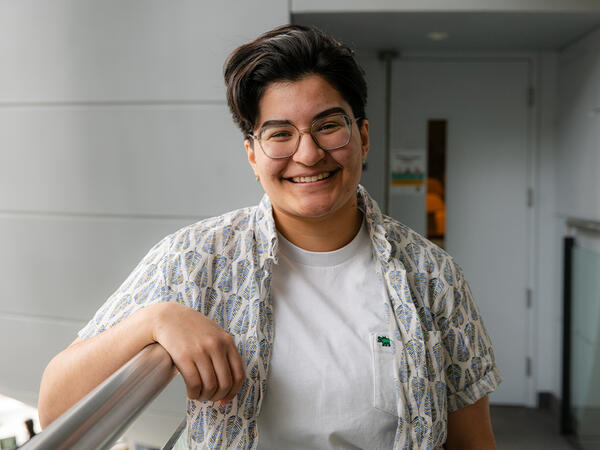One hundred years after the discovery of insulin, pharmaceutical sciences researchers continue to revolutionize health care for people with diabetes and other conditions.
In the 100 years since Frederick Banting and Charles Best discovered insulin as a treatment for diabetes, many things have changed about drug discovery, including the lab equipment, techniques and technology. But what remains the same is the drive that pharmaceutical scientists have to discover drugs that can revolutionize patient care.
“Insulin is a phenomenal example of how important drug discoveries can change the lives of people all over the world,” says Lisa Dolovich, Professor and Dean of the Leslie Dan Faculty of Pharmacy (LDFP). “We’re really proud to be working on therapeutic discovery and new diagnostics that we hope will also have significant impacts on people’s health and quality of life.”
Researchers at the Faculty, whether their research relates to diabetes or other conditions, are part of the legacy of discovery inspired by Banting and Best. And one of the key features of this culture of innovation and discovery is the breadth of expertise and research approaches housed in one Faculty.
“It provides new opportunities and new ways of thinking to infuse our different labs because people can learn from one another,” says Dolovich. “And, of course, we benefit from having students who have been educated in different areas, all coming together in pharmaceutical sciences.”
Understanding mechanism of drug-induced diabetes may lead to new treatments
One of the first stages of drug discovery is understanding cellular pathways and what goes wrong in different conditions, in order to find ways to counteract these effects. “Part of my research is trying to discover new drug targets and then collaborating with chemists to make small molecules that we hope might eventually be turned into therapeutics,” says Carolyn Cummins, Associate Professor at the LDFP. “This drug discovery research is central to the pharmaceutical sciences.”
Cummins studies how glucocorticoids — stress hormones that are often prescribed as anti-inflammatory drugs — cause drug-induced diabetes. These drugs activate a receptor in the liver that stimulates the body to produce glucose, and if they are taken chronically, predispose patients to conditions such as obesity and diabetes.
Her work focuses on the nuclear receptors involved in the glucocorticoid signalling pathways. A better understanding of how these signalling pathways work and what happens when they are overstimulated may suggest new drug targets and a way to dose the anti-inflammatories to avoid this side effect.
Although her work is at the early stages of drug discovery, she says her research is still informed and broadened by considering the patient perspective. “As pharmaceutical scientists, we have the capacity to learn about the patient perspective because we have access to front-line clinicians and pharmacists,” she says.
Clinical collaborations key to moving research forward
Interacting and collaborating with clinicians is one of the key elements of Shana Kelley’s research that enhances her ability to make new breakthroughs, but also see first-hand the challenges that remain related to curing disease.
“If you go to see a collaborator at a hospital, you cannot miss seeing the people who are there to receive care,” says Kelley, University Professor. “We have a very collaborative clinical community in Toronto, and it is such a huge resource for people like me, but it also keeps the patients top of mind.”
Kelley and her team develop technologies that use molecular biology and nanotechnology to detect and diagnose disease and look for drug targets in large volumes of sample, and they frequently collaborate with clinicians to access patient samples. Much of their work has focused on systems that scan large populations of cells to look for specific genetic sequences or mutations, which can be used for early detection of diseases such as cancer.
But her team isn’t focused on one disease. They apply their expertise to solve problems that apply to different types of conditions.
“Pharmaceutical science is a broad field, and it’s very inclusive,” says Kelley. “In our Faculty, we feel really strongly about solving critically important problems, and so it has a culture that lends itself to discovering new things and developing new technologies.”
This focus on applying discoveries to solve problems is a strength of the LDFP. “We see beyond the boundaries of one medical area or one condition and look at these problems from the drug perspective or from the device perspective,” says Dolovich. “We can build on discoveries that have happened within the context of one medical condition being considered for others.”
Drug delivery technologies for improving patient health
Professor Shirley Wu and her team develop new drug delivery technologies to ensure drugs reach their intended targets in the body. Their research is highly multidisciplinary and can be applied to many different diseases, thus collaborations with experts in these diseases is essential. “A lot of work can’t be done with just one lab,” says Wu. “We have the technology to improve drug delivery, but we need other people’s expertise to understand the biology and assess what we develop.”
Her team has led work relating to a number of conditions, including cancer, diabetes and Alzheimer’s disease. To improve insulin therapy in diabetes, her team has studied intelligent insulin delivery over the last two decades. Recently, they developed a “smart” microneedle patch to help people with diabetes manage hypoglycemia, a potentially dangerous complication of insulin therapy. The patch senses low blood sugar levels and, in response, automatically releases the hormone glucagon, which raises blood sugar levels. The non-invasive and painless device is currently in preclinical development.
Wu says that her team approaches their research with the intent to make a difference for patients. “We want to improve patient care, their health and their lives,” says Wu. “After we published the first paper on the microneedle patch, we received multiple emails from patients and relatives asking when and where we were going to run clinical trials. This is an in-demand treatment, which motivates us to work harder and faster toward clinical use.”
Advanced biologics may help treat complications of diabetes
When insulin was discovered 100 years ago, it was the first biologic treatment – a protein to treat disease. A century later, researchers at the LDFP are developing advanced biologics to help treat conditions such as diabetic retinopathy, a form of blindness that affects about a third of people with diabetes.
An impermeable physiological barrier in blood vessels around the eye – the blood-retina barrier – protects the eye from molecules circulating the body through the blood. But in diabetes, high blood sugar levels cause the barrier to “leak,” damaging the retina and causing blindness.
“Right now, there are limited drugs to treat diabetic retinopathy and they don’t work for everyone, so there’s an urgent need to develop other medications that could benefit patients,” says Stéphane Angers, Professor and Associate Dean of Research. “We’re developing a biologic that uses a completely different mechanism than the existing treatment, and our preclinical research shows that this biologic is very powerful for promoting barrier function.”
Angers and his team developed an antibody that regulates a signalling pathway involved in blood-retina barrier function in order to promote the formation and strengthen the barrier. To help bring this biologic treatment to the clinic, he has launched a start-up company to complete the preclinical work, and he hopes that the drug will be ready to start clinical trials within a couple of years.
“Our Toronto-led effort to develop a biologic for people with diabetic retinopathy follows the legacy of Banting and Best,” says Angers. “Being in a drug discovery ecosystem, we’re ideally positioned at the LDFP to develop new drugs and translate our research into drug therapies.”
Clinical experience informs drug discovery process
Just as researchers aim to move discoveries into the clinic, clinician-scientists also bring their front-line perspectives back to drug discovery.
“Because we have health professionals and students learning and working alongside those who are focused on scientific discovery, we can cross the bridge from drug discovery to health care,” says Dolovich. “It allows us to think about how new drug discoveries are going to impact patients and their care and the professionals who deliver that care. All that information feeds back into the drug discovery process.”
Marisa Battistella is a pharmacist and clinician-scientist specializing in chronic kidney disease (CKD). “People with diabetes are at higher risk for other conditions, including CKD, and often take many different types of medication, which may result in drug interactions.”
Battistella’s research focuses on pharmacy practice, including using genomics to guide drug selection, and optimizing patient medications, which may also include deprescribing. She agrees that the having clinical and basic scientists working together helps to spur innovation in drug discovery.
“Clinician-scientists and basic scientists are all trying to improve patient care – that’s our ultimate goal. Having these collaborations is really important and they can inform each other in ways to improve research and patient care,” she says. “I have the relationships at the hospital to roll out discoveries made in the lab, but we can also explain to researchers at the Faculty how we translate research or clinical studies into practice.”
Battistella is also active in education, not only as a course instructor and coordinator, but also serving as a preceptor and mentor. “Students often ask really good questions or they dig deeper into a particular disease or medication,” she says. “Their questioning minds help inform my thinking and help me to think deeply and consider ideas or research questions we could pursue.”
With nearly four million Canadians living with diabetes and this number projected to grow over the coming years, students at the LDFP, both in pharmacy and pharmaceutical sciences, will play active roles in improving diabetes care in the future.
“We’re proud that we graduate pharmaceutical scientists and pharmacists who will be in a position to help people with diabetes, whether it’s in community pharmacy, in hospital, or research settings,” says Dolovich. “We do our best to prepare our students to take up the challenge and contribute as integral members of the health care team.”
By: Eileen Hoftyzer
More News
Image

Jeffrey Henderson Receives Prestigious Connaught Innovation Award
Award will support research to advance novel method of modifying cells for testing new gene therapies.
Read More
Image

Faces of PharmSci: Mahya Rezaeifarimani
Supervised by Prof. Shirley Wu, PhD student Mahya Rezaeifarimani is developing smart nanoparticles to help make radiation therapy work better for brain tumours by targeting low-oxygen areas that often make treatment less effective.
Read More
Image

Dean Lisa Dolovich reappointed for second term
Professor Lisa Dolovich has been reappointed for a second term as Dean of the Leslie Dan Faculty of Pharmacy, University of Toronto, effective July 1, 2025, to December 30, 2030.
Read More





